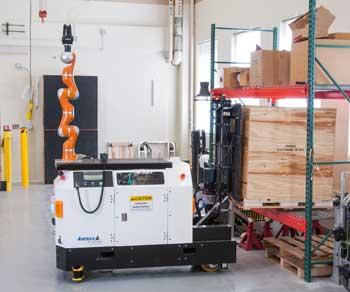
Automated guided vehicles—or AGVs—are robotic versions of draft animals, hauling heavy loads and navigating their way in factories, distribution centers, ports and other facilities. These modern beasts of burden are evolving so rapidly in capabilities and electronic intelligence that the need for the equivalent of standardized performance testing has become apriority for the fast-growing AGV industry and its customers.
Responding to that need is precisely the aim of a new ASTM International standards committee chaired by Roger Bostelman, a National Institute of Standards and Technology (NIST) electronics engineer who specializes in intelligent control systems technologies. Bostelman has been a strong advocate for developing voluntary, industry-consensus standards for measuring—and comparing—what AGVs can do.
He spent the last two years discussing the merits of common methods for assessing performance with AGV manufacturers, component suppliers and users of the technology. In those exchanges and in a "white paper,"Bostelman made it clear that standard test methods are industry-shared tools for evaluating and comparing performance—and not specifications dictating the design or manufacture of AGVs.
Standards, metrics, and test methods will be driven by requirements articulated by end-users and AGV manufacturers, Bostelman says.
"There are many benefits to be gained," he explains. "Prospective customers would be able to compare how well AGV products fit their manufacturing and distribution needs. This reduces the risk of investing in and implementing a new technology. So performance standards can help to expand the market. The standards also will allow AGV manufacturers to report the results of performance tests as a marketing tool."
AGV safety standards are already well in hand, thanks to the work of a committee formed by the American National Standards Institute and the Industrial Truck Standards Development Foundation. But Bostelman, who serves on the committee, says the committee's safety standards do not directly address task performance and intelligence. As examples of potential performance standards, he lists tests for measuring how well an AGV navigates around obstacles and docks at a series of specified stops and metrics for evaluating how vehicles perform under different environmental conditions such as rough or smooth surfaces and variations in temperature and lighting.
After a series of meetings, key stakeholders became convinced of the value of standard tests. And in late April 2014, ASTM's board of directors approved the creation of ASTM Committee F45 on Driverless Automatic Guided Industrial Vehicles. The new committee will focus on developing common terminology, recommended practices, guides, tests and performance standards.
A U.S. invention, AGVs have been used since the 1950s, but adoption has been gradual. More than 3,000 of these driverless systems—ranging from one vehicle to more than 100—are estimated to have been installed in the United States over the last 50 years. But the market is beginning to take off. Inc. magazine included AGVs on its list of best industries for starting a business in 2014.
A burst of innovation over the last decade has spawned a growing variety of AGVs, from towing carts and forklift-like vehicles to small shelf-moving robots and haulers of massive loads. Computer-controlled and, usually, battery powered, AGVs negotiate their way using flexible, easy-to-reconfigure guidance technologies that include optical sensors, lasers, surface-mounted magnetic tape, and inertial guidance.
To learn more about the new standards committee, read "Steering a New Course" in ASTM International's Standardization News.

